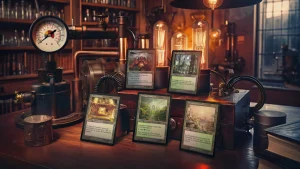In the world of tabletop gaming, Magic: The Gathering (MTG) stands out as a beacon of strategic depth and engaging gameplay. Since its inception in 1993, MTG has enchanted millions of players worldwide, offering a rich tapestry of lore, complex mechanics, and the thrill of competition. At its core, the game is structured around five distinct phases that guide each turn, creating a dynamic flow of play that challenges both novices and seasoned veterans alike.
In this article, we will embark on a journey through these five phases, exploring the strategic nuances that make MTG a beloved pastime. Additionally, we’ll delve into how enthusiasts utilize print proxy MTG to enhance their gaming experience, ensuring both accessibility and enjoyment for players of all levels.
Phases of Magic
Untap Phase: The Dawn of Strategy
As the first light of dawn dispels the darkness, the Untap Phase signifies the beginning of a player’s turn. In this phase, all tapped cards are refreshed, ready to be wielded once again.
This represents not just a reset of resources but also the endless possibilities that lie ahead in the turn. The strategic implications are profound, as players must wisely manage their resources to maintain momentum and outmaneuver their opponents.
Upkeep Phase: The Strategy Unfolds
Following the renewal of the Untap Phase, the Upkeep Phase demands attention and foresight. Some cards require specific actions or decisions during this phase, setting the stage for the turn’s strategic narrative.
Players must carefully plan their moves, anticipating both their needs and their opponent’s responses. This phase is a testament to the game’s depth, where every decision can tip the scales of victory.
Draw Phase: The Heart of Discovery
At the heart of any adventure lies discovery, and the Draw Phase embodies this spirit in MTG. Drawing a card adds an element of chance and strategy, offering new opportunities and challenges. This phase fuels the game’s dynamic nature, ensuring that no two matches are ever the same. Players must adapt their strategies based on their evolving hand, navigating the uncertain waters of fortune and strategy.
Main Phase: The Arena of Action
The Main Phase is where the magic truly happens. Players can summon creatures, cast spells, and set traps, each action weaving into the tapestry of an unfolding story. This phase is the crucible of strategy, where plans are executed, and battles are fought. It’s a test of wit and will, demanding both creativity and cunning to achieve victory.
Combat and Second Main Phase: The Climax of Confrontation
The Combat Phase and the subsequent Second Main Phase serve as the climactic confrontation of each turn. Here, players engage in battles, deploying creatures and spells in a bid for dominance.
The Combat Phase is a dance of attack and defense, a thrilling exchange of blows that can turn the tide of the game. Following the fray, the Second Main Phase allows for recovery and further actions, setting the stage for future turns.
The Role of Print Proxy MTG in Enhancing Gameplay
Amidst the strategic complexity of MTG, print proxy MTG emerges as a beacon of accessibility and innovation. Proxies allow players to use printed versions of cards, making the game more accessible to those who may not have extensive collections.
This practice encourages experimentation and learning, enabling players to test strategies and decks without significant investment. It embodies the spirit of inclusivity and creativity, ensuring that the joy of MTG can be shared by a broader community.
FAQs
Is there a main Phase 2 in Magic?
Yes, in Magic: The Gathering, there is a Main Phase 2, which occurs after the Combat Phase and allows players to cast sorcery-speed spells, activate abilities, and play lands, similar to the Main Phase 1.
How many combat phases are there in Magic?
In Magic: The Gathering, there is one Combat Phase per turn, which includes several steps: Beginning of Combat, Declare Attackers, Declare Blockers, Combat Damage, and End of Combat.
What is the stack in MTG phases?
The stack in Magic: The Gathering is a game zone where spells and abilities are placed when they are cast or activated. The stack allows players to respond to these spells and abilities in a last-in, first-out order. It is not a phase but a game mechanism that is used throughout various phases.
Do you lose mana between phases?
Yes, in Magic: The Gathering, any unused mana in a player’s mana pool empties between phases and steps, causing the player to lose that mana. This rule is often referred to as “mana burn” in older rules, though the loss of life from unspent mana no longer applies.
Conclusion
In conclusion, the five phases of Magic: The Gathering offer a journey through strategy, anticipation, and exhilaration. Each phase contributes to the game’s depth and appeal, challenging players to think creatively and adapt dynamically.
The inclusion of print proxy MTG further enriches this experience, breaking down barriers and fostering a community united by a love for strategy and imagination. Whether you’re a seasoned veteran or a curious newcomer, MTG invites you to embark on this captivating journey, promising endless adventures in the realms of magic and strategy.
For more Details Visit Printingproxies



